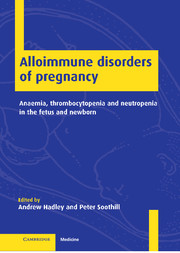 Alloimmune Disorders of Pregnancy
Alloimmune Disorders of Pregnancy Published online by Cambridge University Press: 26 October 2009
The pathogenesis of the alloimmune cytopenias can be considered in four stages: alloimmunization of the mother, the placental transfer of antibodies to a fetus, the immune destruction of sensitized blood cells and, finally, clinical manifestations which are secondary to the destruction of fetal blood cells such as hydrops, haemorrhage or infection.
Maternal Alloimmunization
Some key events in the humoral immune response
A comprehensive review of humoral immune responses is outside the scope of this chapter. Nevertheless, a brief consideration of the cells and some of the key processes which result in the production of antibodies is pertinent to several topics covered in this book such as the genetic predisposition to form certain alloantibodies (Section 1.1.3), the mode of action of Rh prophylaxis (Section 5.5), and the basis of new approaches to ameliorate maternal alloimmune responses (Section 14.5). These key steps are shown diagrammatically in Figure 1.1.
Two phases of an immune response are distinguished. The primary response results in very low or undetectable levels of circulating antibody. The second anamnestic response is characterized by much higher concentrations of antibody. The immune response starts with the nonspecific uptake of an antigen by antigenpresenting cells in lymphoid centres such as the spleen and lymph nodes. Internalized antigens are then incorporated into phagolysosomes where they are partially degraded by proteolytic enzymes to peptide fragments. The peptides then associate with HLA class II molecules before being returned to the cell surface and so ‘presented’ to helper T cells.
To save this book to your Kindle, first ensure [email protected] is added to your Approved Personal Document E-mail List under your Personal Document Settings on the Manage Your Content and Devices page of your Amazon account. Then enter the ‘name’ part of your Kindle email address below. Find out more about saving to your Kindle.
Note you can select to save to either the @free.kindle.com or @kindle.com variations. ‘@free.kindle.com’ emails are free but can only be saved to your device when it is connected to wi-fi. ‘@kindle.com’ emails can be delivered even when you are not connected to wi-fi, but note that service fees apply.
Find out more about the Kindle Personal Document Service.
To save content items to your account, please confirm that you agree to abide by our usage policies. If this is the first time you use this feature, you will be asked to authorise Cambridge Core to connect with your account. Find out more about saving content to Dropbox.
To save content items to your account, please confirm that you agree to abide by our usage policies. If this is the first time you use this feature, you will be asked to authorise Cambridge Core to connect with your account. Find out more about saving content to Google Drive.